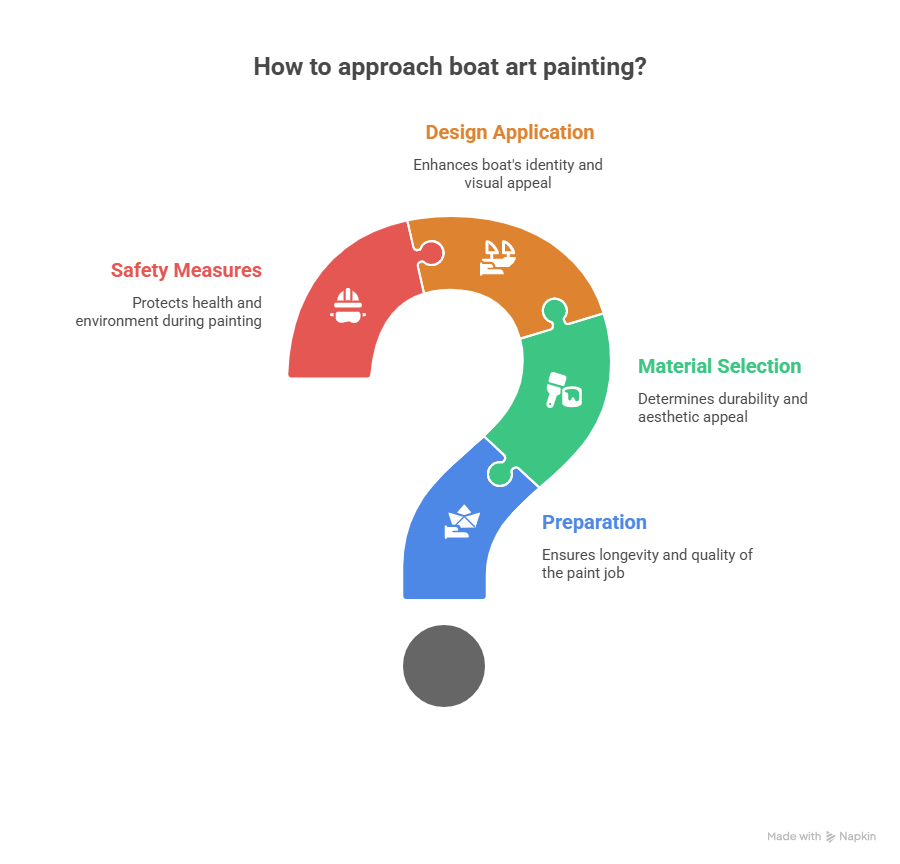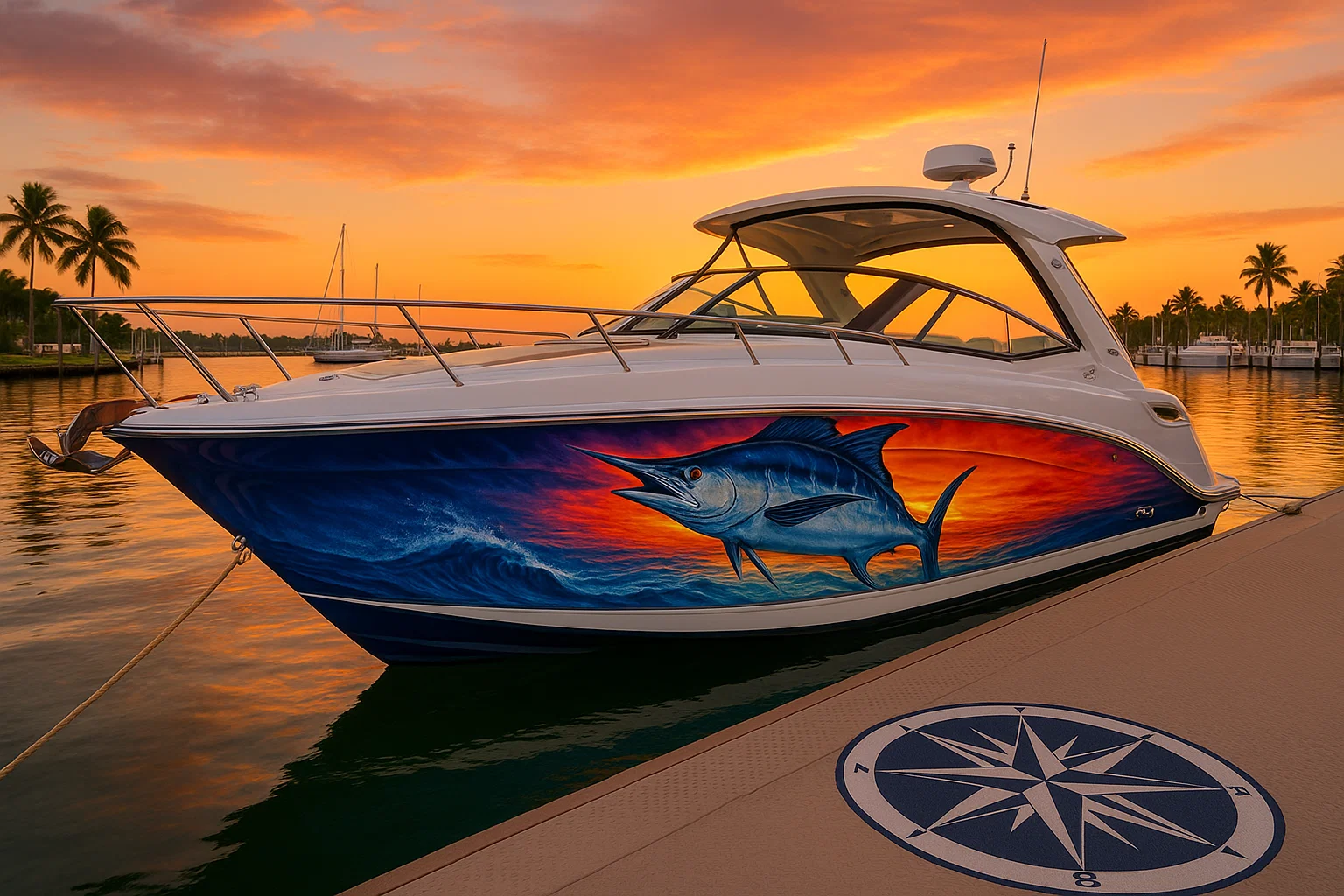I’ve been painting boats in South Florida’s marinas for 15 years, and nothing beats the feeling of turning a plain hull into a head-turning piece of boat art painting. Last June, a client named Javier at Dinner Key Marina wanted his Sea Ray 350 to stand out. His faded hull became a vibrant mural of a leaping marlin—took three weeks but wowed everyone at the dock. Boat art painting isn’t just about looks; it’s about giving your vessel a soul that survives sun and salt. Here’s how I transform boats into floating art, with tips to make your boat art painting project shine.
Table of Contents
Why Does Boat Art Painting Matter?
Boat art painting gives your vessel a unique identity. A custom mural or bold lettering makes your boat unforgettable, whether it’s docked in Miami or cruising Key Biscayne. I’ve seen owners’ faces light up when their boat reflects their personality—it’s like hanging a masterpiece in a gallery, except it floats.
How Do I Start a Boat Art Painting Project?
Every great boat art painting starts with preparation—90% of the work happens before you touch a brush. In 2019, I rushed a job in Fort Lauderdale and ended up with peeling paint after one season. Never again. Clean the hull with boat soap and a dewaxing agent to remove salt and grime. Sand it lightly to create a “tooth” for the paint to grip, then apply a high-quality marine primer. This ensures your boat art painting lasts years, not months.
What Materials Are Best for Boat Art Painting?
Choosing the right materials is critical for durability. For boat art painting, I use two-part polyurethanes for their toughness—they withstand Florida’s UV rays and saltwater. Marine enamels are easier for beginners but less durable. For primers, I swear by Interlux Pre-Kote; it bonds like glue. My toolkit includes 4-inch foam rollers for smooth coats, fine brushes for details, and an airbrush for gradients. Last summer, I used an airbrush on a client’s Boston Whaler for a sunset mural—stunning results.
Preparing Your Boat for a Stunning Paint Job
Preparation is the backbone of boat art painting. A flawless surface means your art won’t peel or fade. Here’s my process, honed over 200+ projects.
How Do I Clean and Prep the Hull?
Start with a thorough wash using marine-grade soap—don’t skip the dewaxer; wax ruins adhesion. Sand with 220-grit paper to scuff the surface, not strip it. I learned this the hard way in 2012 when a client’s Bayliner 285 showed blisters after I skipped sanding. Mask off areas with 3M painter’s tape for crisp, clean edges—key for geometric designs in boat art painting. Prime with a marine-grade primer; I used two coats on Javier’s Sea Ray for a rock-solid base.
Why Is Safety Crucial in Boat Art Painting?
Marine paints have volatile organic compounds (VOCs) that demand caution. I always wear a respirator, safety glasses, and chemical-resistant gloves—saved my lungs on a humid July job in Coconut Grove. Work outdoors on a calm day or in a ventilated shed. Use plastic sheeting to catch overspray; I once saw a marina fine a guy $500 for polluting the water. Safety keeps your boat art painting project clean and legal.
Designing Your Hull: Making a Bold Statement
Your hull is a massive canvas for boat art painting. It’s where your boat’s personality shines, whether through a mural or a custom name.
What Designs Work Best for Boat Art Painting?
The best designs tie to your boat’s name or your story. In 2023, a client at Stiltsville wanted a kraken mural on her Grady-White 208—took 40 hours but looked epic. Marine themes like dolphins or waves are timeless, but I love abstract geometric designs for a modern vibe. For names, try creative typography—a wave in the “W” or a hook in the “J.” Brainstorm a theme that screams you before sketching.
How Do I Apply Boat Art Painting to the Hull?
Hand-painting offers artistic freedom; I painted a turtle mural freehand on a client’s boat last spring—felt like true art. Vinyl wraps are faster and removable, perfect for intricate designs. For realism, an airbrush creates soft gradients, like the sunset on that Boston Whaler. For elegance, gold leaf lettering is unmatched—I added it to a yacht’s name in Bahia Mar, and it gleamed like jewelry. Choose the method that fits your boat art painting vision.
Deck and Interior Art: Functional Beauty
Boat art painting isn’t just for the hull. Decks and interiors can become functional art, enhancing your time on board.
How Can I Paint a Non-Skid Deck Artistically?
Non-skid decks need grip, but they can still dazzle. I painted a compass rose on a client’s cockpit deck in Key Biscayne last year—safe and stylish. Use stencils for precision or freehand for an organic feel. Mix grip additives into marine paint; KiwiGrip’s my go-to for durability. Faux teak designs mimic wood without the upkeep—saved a client $2,000 in maintenance.
How Do I Add Art to the Cabin?
Cabin art adds warmth. I painted a nautical chart on a cabin table for a Miami client, sealed with epoxy resin—gorgeous and tough. Try murals on bulkheads or colorful trim on cabinet doors. Last month, I painted a wave pattern on a companionway step—small but impactful. Use durable epoxy resin for surfaces like tables to handle spills and wear.

How Do I Protect Boat Art Painting Onboard?
A UV-resistant clear coat is non-negotiable for boat art painting. I use Awlgrip Clear for hulls and decks; it shields against sun and salt. For high-traffic areas like steps, add an abrasion-resistant finish—saved a client’s deck art from fading after a busy season. Without protection, your art won’t survive a Florida summer.
Painting Nautical Scenes for Your Home
Boat art painting extends beyond the vessel. Canvas or paper paintings bring the sea’s beauty to your home, capturing your love for boating.
What Scenes Make Great Boat Art Paintings?
Choose a scene with emotion. A solitary boat at sunset, with fiery oranges reflecting on the water, feels serene—painted one for my office in 2020. Bustling harbors with mirrored hulls are lively; I used acrylics for one last spring. A weathered boat on a beach, with peeling paint and ropes, tells a story. Pick a mood that resonates.
What Techniques Work for Boat Art Painting on Canvas?
Acrylics are great for vibrant, textured waves—use a palette knife for sea foam. Watercolors excel for soft skies; I used wet-on-wet for a misty harbor scene last year. For details like spray or clouds, a nearly dry brush adds realism. These techniques make your boat art painting pop with life.
FAQ: Common Boat Art Painting Questions
How Long Does a Boat Art Painting Project Take?
Most boat art painting projects take 1–3 weeks, depending on complexity. A simple name might take a weekend, but a mural like Javier’s marlin took 20 days. Prep eats the most time—cleaning and priming can take 5–7 hours alone. Plan ahead and work in good weather. Try a local shop like Miami Marine Art for faster results.
What’s the Cost of Boat Art Painting?
Costs range from $500 for basic lettering to $5,000 for full hull murals. My last project, a geometric wrap, cost $2,000 with vinyl. Materials like polyurethane paint and epoxy resin add $100–$300. DIY saves money but requires skill. Check suppliers like West Marine for quality paints.
Can I Do Boat Art Painting Myself?
Yes, if you’re handy and patient. Start small—paint a cabin door or deck pattern. I taught a buddy to stencil a compass rose in 4 hours. Use marine-grade paints and follow prep steps. For complex murals, hire a pro like Sofia’s Art Studio in Fort Lauderdale to avoid mistakes.
How Do I Protect Boat Art Painting from Sun and Salt?
A UV-resistant clear coat like Awlgrip is essential. I apply two coats to hull art; it saved a mural from fading in 2023. For decks, use an abrasion-resistant finish—KiwiGrip works great. Reapply clear coat every 2 years. Test with a small area first.
What Paints Are Best for Boat Art Painting?
Two-part polyurethanes are toughest but tricky to apply. Marine enamels are easier for DIYers. I used Interlux Brightside on a client’s table—great finish for $50. Always prime with Interlux Pre-Kote. Buy from marine suppliers for best quality.
How Do I Choose a Design for Boat Art Painting?
Pick a design that reflects you. I sketched a dolphin mural for a client’s kid in 2024—loved it. Marine themes, abstracts, or custom lettering work well. Browse Pinterest for ideas or consult a marine artist. Test sketches on paper first.
Is Vinyl or Hand-Painting Better for Boat Art Painting?
Hand-painting gives artistic freedom; I love the organic feel of freehand waves. Vinyl wraps are precise and removable—great for rentals. I did a vinyl wrap in 2 days versus 5 for hand-painting. Choose based on time and budget. Local shops offer both options.
Conclusion
Boat art painting transforms your vessel into a floating masterpiece. It’s not just about aesthetics—it’s about crafting an identity that turns heads at Bahia Mar or off Stiltsville. Prep is everything; a clean, primed hull ensures your art lasts. From murals to deck designs, every surface is a canvas. Protect it with UV-resistant clear coats, and don’t rush—my botched 2019 job taught me that. Start small with a painted name or cabin accent, and let your vision shine. Your boat deserves to be an unforgettable landmark on the water.
Author Bio
I’m Alex, a 15-year marine artist in South Florida, specializing in boat art painting. I’ve painted 200+ boats, from Sea Rays to yachts, across Miami and Fort Lauderdale. Certified by ABYC, I’m passionate about turning vessels into art.


Leave a Reply